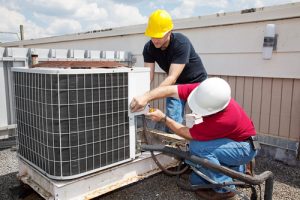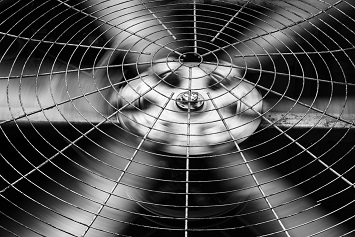You may worry about a workplace outbreak of coronavirus disease 2019 (COVID-19) in your offices or facilities, but do you need to budget for upgrading your heating, ventilation, and air conditioning (HVAC) systems to hospital-grade standards?
Researchers are still learning about the SARS-CoV-2 virus and how the coronavirus disease it causes is transmitted. They know infections occur in close contact between individuals, especially within 6 feet. They are less sure about transmission through contact with surfaces, although nearly all public health authorities still emphasize cleaning and disinfecting commonly touched surfaces.
Public health authorities have not reached a consensus on whether the virus is “airborne” or “aerosolized.” The difference is that an airborne disease could be more easily transmitted than one borne by aerosolized particles.
In a now well-known “super spreader” event, 32 confirmed infections and 20 probable infections happened during a choir practice, probably by transmission through an infected person’s singing. The report underscores the importance of physical distancing during the ongoing pandemic and highlights the health risks of indoor spaces.
Some public health experts have argued the virus is airborne in indoor spaces. In a preprint journal article not yet peer-reviewed, researchers reported finding SARS-CoV-2 genetic material collected on air samplers in a room occupied by a person with a confirmed COVID-19 infection. In an early release of an Emerging Infectious Diseases article, researchers found surfaces in the rooms of quarantined students were contaminated with SARS-CoV-2 RNA.
Two Harvard Medical School researchers suggested in the Journal of the American Medical Association that air disinfection in healthcare facilities may be just as important as using fitted N95 respirators to protect healthcare workers from COVID-19 infections.
While there is no consensus on the likelihood of airborne COVID-19 transmission, the possibility has implications even for nonhealthcare facilities like offices, manufacturing facilities, retail stores, and warehouses. Employers and building managers need practical steps they can take to limit or prevent infections in indoor spaces.
The Centers for Disease Control and Prevention (CDC) issued interim guidance for businesses and employers, recommending a series of engineering and administrative controls and work practices like social distancing, wearing cloth face coverings, and installing plexiglass or other barriers to curb transmission. The National Safety Council’s SAFER Framework included additional recommendations like implementing workplace COVID-19 testing and contact tracing to prevent and control outbreaks.
The EPA has noted the growing evidence behind airborne transmission and suggested increasing ventilation and air filtration. ASHRAE (formerly, the American Society of Heating, Refrigerating, and Air-Conditioning Engineers) issued an emerging issue brief on COVID-19 and airborne transmission.
It is ASHRAE’s position that “ventilation and filtration provided by heating, ventilating, and air-conditioning systems can reduce the airborne concentration of SARS-CoV-2 and thus the risk of transmission through the air.”
The EPA’s position is that while improvements in ventilation and filtration cannot eliminate the risk of SARS-CoV-2 transmission on their own, the Agency recommends taking precautions through HVAC improvements to reduce the potential for airborne transmission. The EPA suggests increasing ventilation air filtration along with implementing other precautions like social distancing, wearing cloth face coverings or masks, surface cleaning and disinfecting, and hand-washing. The Agency maintains a list of disinfectants for use against SARS-CoV-2. The CDC, EPA, and the Occupational Safety and Health Administration (OSHA) all recommend regularly cleaning and disinfecting commonly touched surfaces in public indoor spaces, including workplaces.
 ASHRAE recommends that businesses and employers consider implementing non-HVAC interventions like reducing building occupancy; social distancing in break rooms, conference rooms, elevators, and between desks; face mask requirements or recommendations; cleaning and disinfecting surfaces; and encouraging hand-washing and good respiratory hygiene, along with HVAC interventions. Possible HVAC strategies can include increased ventilation, improved filtration, and air-cleaning devices like ultraviolet germicidal irradiation (UVGI).
ASHRAE recommends that businesses and employers consider implementing non-HVAC interventions like reducing building occupancy; social distancing in break rooms, conference rooms, elevators, and between desks; face mask requirements or recommendations; cleaning and disinfecting surfaces; and encouraging hand-washing and good respiratory hygiene, along with HVAC interventions. Possible HVAC strategies can include increased ventilation, improved filtration, and air-cleaning devices like ultraviolet germicidal irradiation (UVGI).
Businesses and employers will need the services of facilities staff and vendors to properly manage or upgrade HVAC systems. They need to take additional precautions in facilities that remained unoccupied during state stay-at-home orders. Standing water in plumbing and ventilation systems is vulnerable to legionella incursion, resulting in Legionnaire’s Disease infections.
While hospitals and healthcare facilities may have HVAC systems with components like high-efficiency filters and UVGI that can effectively eliminate viruses, simple steps may help prevent or reduce infections in the workplace and include:
- Opening windows—letting in outdoor air is the easiest way to ventilate indoor spaces.
- Rearranging seating in an office to avoid having too many people in the same path of airflow.
- Allowing HVAC systems to run even when buildings are unoccupied instead of shutting down systems on evenings and weekends.
While human transmission of the SARS-CoV-2 virus is new, some of the science around ventilation and infection control is decades old. Steam radiator heat was deployed following the global influenza pandemic of 1918 and 1919 to enable building occupants to open windows during winter.
The World Health Organization (WHO), along with the World Meteorological Organization Joint Office for Climate and Health and U.S. National Oceanic and Atmospheric Administration (NOAA), has recommended several steps that businesses, employers, and building managers should consider to improve indoor ventilation and air filtration:
- Consider using natural ventilation, opening windows if possible and safe to do so.
- Increase the percentage of outdoor air in mechanical systems, first verifying compatibility of increased outdoor air with the capabilities of existing building HVAC systems for both temperature and humidity control, as well as compatibility with outdoor/indoor air quality considerations.
- If possible, increase total airflow supply to occupied spaces.
- Disable demand-control ventilation controls that reduce air supply based on indoor space temperature or occupancy.
- Increase air filtration to as high as possible without significantly diminishing design airflow; some HVAC systems cannot handle higher-efficiency filters that require higher air pressure.
- Inspect filter housing and racks to ensure appropriate filter fit, and check for ways to minimize filter bypass.
- Ensure exhaust fans in restroom facilities are functional and operating at full capacity when the building is occupied.
WHO suggests that businesses, employers, and building managers consider running the HVAC system at maximum outside airflow for 2 hours before and after spaces are occupied. As noted above, other groups have recommended continuous HVAC system operations, including during evening and weekend hours.
Filtration and irradiation are common methods of purifying contaminated air. Irradiation, using direct germicidal ultraviolet (UV) light, is impractical in occupied spaces because the light is harmful to the eyes and skin. Air purification by UVGI happens within a purpose-built system, forcing air past a UV lamp. It’s not as simple as wiring a UV lamp into a commercial building’s existing HVAC system.
The effectiveness of filtration varies depending on the type of filter used. High-efficiency particulate air (HEPA) filters can capture over 99% of particles like bacteria and viruses. HEPA filters typically are used in laboratories or industrial “clean rooms” and require high air pressure. HVAC systems with HEPA filters have higher pressure requirements than typical commercial and residential systems.
ASHRAE recommends that building operators use a filter with a Minimum Efficiency Reporting Value (MERV) of 13, but the group suggests that a MERV 14 (or better) filter is preferred. The MERV scale (with values from 1 to 16) measures the effectiveness of filters. Most residential and commercial HVAC systems generally use filters rated MERV 12 or lower. MERV 5 to 8 filters typically can trap dust mites and pet dander, but most residential HVAC service providers recommend MERV 9 to 12 filters as the best options for homes.
The National Air Filtration Association (NAFA) recognizes that while some higher-efficiency filters can remove particles that contain a SARS-CoV-2 virus, low-efficiency filters—less than MERV 8—are unlikely to make a difference. While HVAC systems in hospitals and other healthcare facilities are specifically designed for higher air filtration, residential systems and HVAC systems in most commercial buildings are not designed for higher air filtration due to the higher air pressure requirements.
Industrial hygienists have long advocated for improved indoor air quality in offices and other public indoor spaces. However, employers and building owners may hesitate to embrace “healthy building” upgrades above current, acceptable minimums. Yet the costs of “healthy building” upgrades may need to be weighed against productivity losses, especially if medical researchers cannot deliver effective treatments and vaccines for COVID-19.
But retrofitting an office building, a manufacturing or processing plant, or a warehouse with hospital-grade air filtration may be hard to justify. Infection control is not a typical occupational health concern outside of a hospital or other healthcare facility. The costs make even less sense when lower-cost interventions may be just as effective in preventing workplace outbreaks.
 You may want to continue offering telecommuting or work-from-home options, especially for those at risk for severe illness like older workers and workers with chronic illnesses. Staggering workdays and hours can limit the number of employees in your facility at any given time. Infection often is a function of the length of time spent in an indoor space and the number of people in that occupied space.
You may want to continue offering telecommuting or work-from-home options, especially for those at risk for severe illness like older workers and workers with chronic illnesses. Staggering workdays and hours can limit the number of employees in your facility at any given time. Infection often is a function of the length of time spent in an indoor space and the number of people in that occupied space.
Cloth face coverings can impede the flow of aerosolized particles from an infected individual. The CDC published results of a study revealing no SARS-CoV-2 transmission from infected hairdressers when the hairdressers and all their clients wear face coverings. There’s no consensus yet about whether a cloth mask protects the wearer from infection. Cloth face coverings and surgical masks are not recognized personal protective equipment that filter out particles.
Engineering controls may have higher costs than administrative controls but may be necessary when practices like social distancing are impractical. You may need to install physical barriers like plexiglass panels when spacing desks or workstations is impractical. The CDC and OSHA have recommended installing physical barriers like plexiglass or another material, strip curtains, or impermeable dividers or partitions to separate workers from each other in meat, poultry, and seafood processing facilities. Meatpacking facilities have been the sites of several workplace COVID-19 outbreaks.
Certain industrial processes and tasks require more robust ventilation and often utilize local exhaust ventilation to eliminate harmful occupational exposures to vapors, gases, fumes, and dusts. The American Society of Safety Professionals (ASSP) has a series of ventilation standards (ANSI/ASSP Z9) for a variety of work environments, including abrasive-blasting operations, laboratories, and spray finishing operations.

